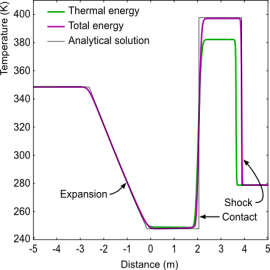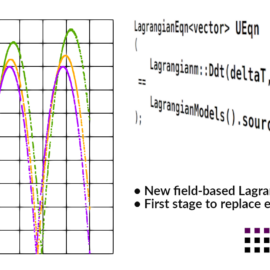This article is a user guide to the new field-based Lagrangian functionality in OpenFOAM. This is a new implementation of Lagrangian functionality where data is stored as fields rather than in the objects representing particles or parcels (particle-based Lagrangian). It will ultimately replace the original particle-based Lagrangian and is 65% complete and available in OpenFOAM-dev. Field-based Lagrangian has the advantages of: better extensibility, since fields can be simply added; greater efficiency of fewer function calls using field algebra; greater code reuse due to consistency with the rest of OpenFOAM.
OpenFOAM Documentation
CFD Direct provide the following Free OpenFOAM Documentation for the users of OpenFOAM. We will periodically add new documents to this resource. The OpenFOAM User Guide is a web-friendly, online version of the latest User Guide provided with OpenFOAM. Please report any corrections to the OpenFOAM Issue Tracking system, where we will endeavour to make corrections as soon as possible.
C++ Source Guides: click here
Useful Tools in OpenFOAM 11

In 2016 we published a guide of Useful Tools in OpenFOAM with tools we first released in OpenFOAM v4. The tools included the post-processing CLI and template cases, and applications such as foamDictionary. We extended the article following the release of new tools such as TAB completion in OpenFOAM v5 and again later with the introduction of new tools in subsequent versions of OpenFOAM. This article describe more significant new tools introduced in OpenFOAM version 11, notably foamToC and foamPostProcess, to provide compatibility with its modular solvers, while maintaining backward-compatibility with application solvers.
OpenFOAM User Guide

The OpenFOAM User Guide provides an introduction to OpenFOAM, through some basic tutorials, and some details about the general operation of OpenFOAM. OpenFOAM is a collection of approximately 250 applications built upon a collection of over 100 software libraries (modules). Each application performs a specific task, e.g the snappyHexMesh application can generate meshes for complex geometry, such as a vehicle. The simpleFoam application could then be used to simulate steady-state, turbulent, incompressible flow around the vehicle…
Using NCC in OpenFOAM

In May 2022, CFD Direct released Non-Conformal Coupling (NCC) in OpenFOAM to connect regions of a domain with independent meshes for applications including rotating geometry. NCC is a robust replacement for the Arbitrary Mesh Interface (AMI) and associated ACMI and Repeat AMI functionalities. This document describes how to use NCC to enable OpenFOAM users to transition from the AMI functionality to NCC. Due to its popularity, AMI remains in OpenFOAM for the next version 10 release in July 2022, but will thereafter be removed. The unreliable ACMI and Repeat AMI functionalities are removed.
CFD Book for OpenFOAM

CFD Direct is delighted to announce its publication of a book Notes on Computational Fluid Dynamics: General Principles. The book is written for people who use CFD in their work, research or study, providing essential knowledge to perform CFD analysis with confidence. It offers a modern perspective on CFD with the finite volume method, as implemented in OpenFOAM and other popular general-purpose CFD software. Fluid dynamics, turbulence (and RAS modelling) and boundary conditions are presented alongside the numerical methods and algorithms in a series of short, digestible notes.
Useful Tools in OpenFOAM

We design our OpenFOAM Training so that users can learn effective CFD, giving them the confidence to carry out CFD analysis, repeatedly, to a defined standard in a timely manner. We provide 4 courses that teach reliable procedures to configure, run and maintain CFD simulations. While creating and improving these courses, we have contributed useful tools to OpenFOAM for more productive CFD, so that users waste less time on routine tasks. They include the post-processing command line interface, template cases, and tools for case setup, monitoring simulations, quick documentation and code customisation.
Computational Fluid Dynamics

Fluid dynamics is concerned with the motion of fluids (liquids and gases) and the forces on them. “Computational” refers to computation of the flow and forces using numerical analysis. We define “computational fluid dynamics” as “the prediction of fluid motion and forces by computation using numerical analysis, generally extended to include heat, thermodynamics, chemistry and solids”. This definition covers a broad range of calculations for numerous scientific and engineering applications, in particular involving heat.
Energy Equation in OpenFOAM

This article provides information on the equation describing conservation of energy relevant to fluid dynamics and computational fluid dynamics (CFD). It first assembles an equation for combined mechanical and thermal energy, i.e. total energy, in terms of material derivatives. It then presents an equation for thermal, or internal, energy. The total energy equation is then provided in terms of local (partial) derivatives, both in terms of internal energy and enthalpy. The implementation of the energy equation in solvers in OpenFOAM is then described.
Tensor Mathematics

This article provides information on tensor mathematics, relevant to fluid dynamics and computational fluid dynamics (CFD). It describes scalars and vectors and typical algebraic vector operations. It follows with second rank tensors, their algebraic operations, symmetry, skewness and tensor invariants such as trace and determinant, higher rank tensors, co-ordinate system and change of axis. Tensor calculus is introduced (div, grad, curl and Laplacian), followed by integral theorems of Gauss and Stokes, with a physical representation of div and curl, and more.
OpenFOAM Linux Guide

This guide provides information and example terminal commands for Linux, relevant to users of OpenFOAM. Commands are written that refer to OpenFOAM, e.g. they include OpenFOAM Linux environment variables. Those commands that refer to OpenFOAM will only function as stated, if they are executed on a machine on which OpenFOAM is installed and the user’s environment variables are set up for OpenFOAM, e.g. as described in the source download page (see Setting Environment Variables).
Need more help? Take a look at OpenFOAM Training
From the architect/co-founders of OpenFOAM and a team that has trained over 3000 people

